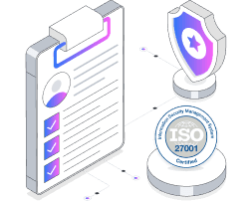What is Web Application Penetration Testing: Steps, Methods and Tools
Due to increasing cyber threats, businesses continuously seek innovative solutions to safeguard their web apps. Web application penetration testing is one of these strategies, and it has already become an integral component of any effective security plan. The popularity of penetration testing, also known as pentest or pentesting, is steadily increasing. According to Markets & Markets, the pentesting industry is expected to increase from $1.4 billion in 2022 to $ 2.7 billion in 2027 at 13.7% of CAGR. In this blog, we’ll explain what penetration testing for a web application is, why it is vital, and what defensive value it provides. What is Web Application Penetration Testing? Web application penetration testing is when cyber security experts replicate a real-world cyber attack on web apps, websites, or web services to uncover potential dangers. This is done to identify existing vulnerabilities that hackers might readily exploit. Within an organization, web servers, whether local or cloud-based, are vulnerable to malicious attacks. Penetration testing involves cyber security experts conducting a series of simulated assaults that imitate genuine unauthorized cyber-attacks, determining the level of the vulnerability, and identifying flaws and the effectiveness of the organization’s overall application security posture. Are you a business seeking web app penetration testing? Your search may have come to an end! Qualysec Technologies can be your partner in safeguarding your web apps. Talk to our expert security consultants for free today! Talk to our Cybersecurity Expert to discuss your specific needs and how we can help your business. Schedule a Call Why Web Application Pen Testing are Performed? Web application penetration testing is an important security measure for any firm that hosts or administers online applications. Web apps are a popular target for cyber thieves due to their widespread use, accessibility, and frequent lack of security protections. According to estimates, 98% of online apps are vulnerable to cyber assaults, which might include malware or redirection to dangerous websites, among other things. Furthermore, 72% of these vulnerabilities stemmed from defects in the program code itself. Here are the top reasons why web app pentests are performed: 1. Identify Vulnerabilities in Web application Penetration testing is critical in identifying security holes before they become a target for attackers. It’s like a treasure hunt, with the wealth being possible vulnerabilities and the hunters being ethical hackers trying to locate these jewels before the pirates do. In doing so, they defend the application’s integrity, user confidence, and data security. 2. Achieving Regulatory Compliance Requirements Meeting compliance is not a simple administrative effort; it signifies developing a trustworthy digital character. The penetration testing process is equivalent to a seafaring vessel undergoing intense inspection before setting sail. This examination ensures that the ship can withstand the unpredictable waves of the digital realm while securely transporting its important cargo—user data. 3. Prevent Hackers from Infiltrating Apps Penetration testing is similar to rehearsing for a real-life breach by a hacker. Regular penetration testing enables you to be proactive in your real-world approach to reviewing the security of your IT infrastructure. The approach exposes flaws in your security, allowing you to correct any deficiencies before an attack happens. 4. Avoid Costly Breaches and Loss of Business Operational Capability Recovering from the consequences of a data breach is undoubtedly expensive. Legal fees, IT remediation, client protection programs, lost revenue, and dissatisfied customers may cost corporations millions. Regular penetration testing is a proactive method to remain on top of your security. It may assist reduce financial loss in the case of a breach while also preserving your brand and image. 5. Gain Useful Insights into Your Web Apps Penetration testing reports can offer you vital information about your network’s vulnerabilities and how to enhance it. These tests are thorough and may be used by pentesters and IT experts for several applications. Penetration testing may help you prioritize your risks and create actionable strategies linked with your company’s beliefs, objectives, and resources, allowing you to focus on particular elements of your IT based on individualized findings. 8 Essential Steps and Methods for Conducting Web Application Penetration Testing To draw attention to the distinction between an application and a web app, pentesting the web application focuses mostly on the environment and configuration of the web app. In other words, testing the web application focuses on getting public information about the web app before moving on to map out the network involved in hosting it. Web application penetration testing often involves the use of a vulnerability scanner to probe and find security flaws such as misconfiguration, unpatched software, SQL injection, cross-site scripting, and so on. Then, manual pentesters penetrate your system; by checking the legitimacy of the vulnerabilities discovered by the scanner. by looking for more complex vulnerabilities, such as business logic problems and payment gateway issues. Here’s an overview of the complete 8 steps procedure of web application Penetration Testing : 1. Obtaining Information: The initial stage in web application penetration testing is to gather as much information as possible. This requires a two-pronged approach: using readily available information from your end and utilizing several approaches and tools to gain technical and functional insights. Understanding user roles, permissions, and data flows is critical for creating an effective testing strategy. 2. Planning and Scoping The pentesters start by carefully establishing the objectives and goals. They probe deeply into the application’s technical and functional complexity. Furthermore, this thorough research enables testers to modify their testing method to target certain vulnerabilities and threats in the application. A thorough web application penetration testing strategy is developed, describing the scope, methodology, and testing criteria. Furthermore, the business provides a high-level checklist to help guide the testing process. They gather and prepare the necessary files and testing equipment. This process comprises creating testing parameters and validating script availability to guarantee a smooth and effective assessment. 3. Auto Tool Scan An automatic and invasive scan is required during the application testing process of web, particularly in a staging environment. This scan thoroughly examines the application’s surface level for vulnerabilities using particular pentesting tools. Furthermore, the automated tools simulate possible attackers by crawling




